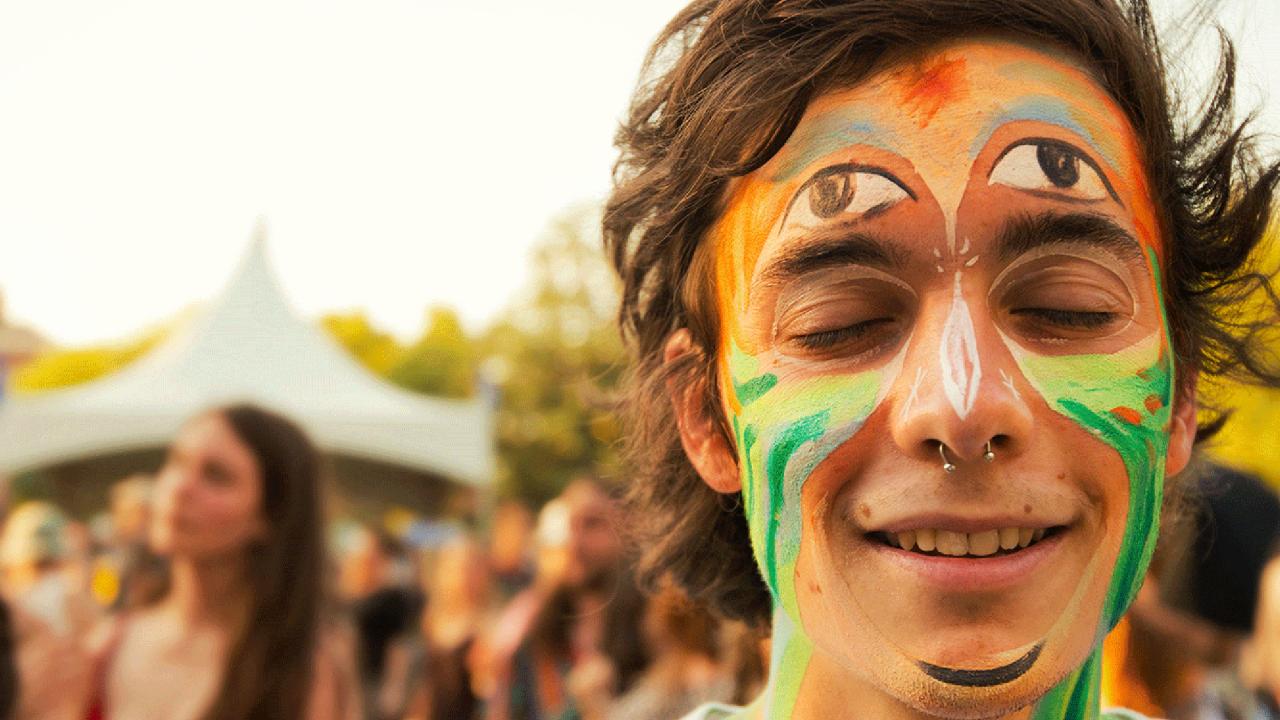The announcement of the first Whole Earth Festival at UC Davis promised “a Global Village of Aquarius will be erected on the central quadrangle of the University.”
It went on to say, “We do not intend to present visions of The End, the Apocalypse, or Armeggedon [sic]. We shall give opportunity to those who wish to inform us of the rapidly deteriorating quality of our soil, food, water and our air. This is, however, a Festival of Life ... ”
Established as part of an art history class taught by José Argüelles, the Whole Earth Festival was originally held in March 1970 to celebrate the spring equinox. That year, San Francisco Mayor Joseph L. Alioto proclaimed March 21 to be Earth Day. (The most-celebrated Earth Day is of course April 22, and was established by former U.S. Sen. Gaylord Nelson and also first held in 1970.)
Today, the festival remains a top draw for visitors on campus each year — second only to Picnic Day — although the emphasis has shifted from the spiritual to the environmental, with the goal of a zero-waste festival.
This year marks the 50th festival, when it is held May 10-12. UC Davis Magazine delved into archives, spoke with alumni and sought memories through social media to tell the story of the Whole Earth Festival — then and now.
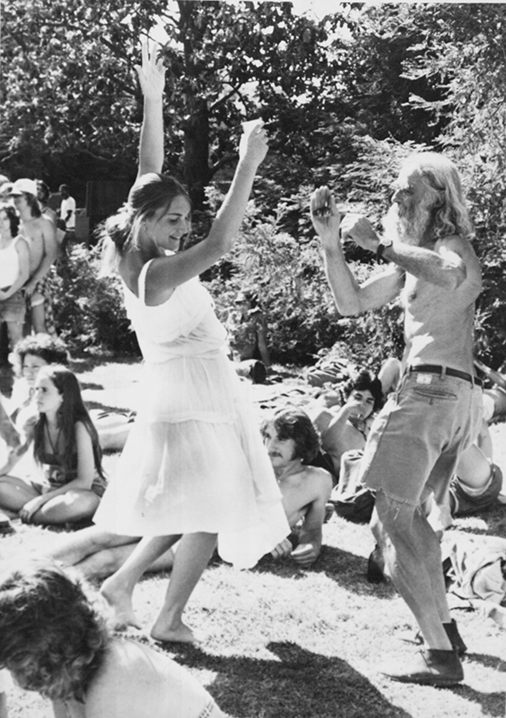
In the beginning
That first year looked a lot like it does today: Artisans displayed their wares, ecology groups provided information on their causes, and musicians performed onstage.
Those in Argüelles’ class remembered a substantive vision behind the event.
“He basically said, ‘Spring equinox is a renewal — let’s do a ritual,’” said Roger Davis, who attended UC Davis at the time, and eventually graduated from the San Francisco Art Institute. “Everybody made an art object, a totem or something important to them.”
Added Steve Macaulay ’71, “[I] still have great memories of that class. José Argüelles was quite an inspiration.”
The Karma Dome was an early addition and still operates as the headquarters for the vast student volunteer network that keeps the festival running. Bob Malmquist ’75 recalled building the first one.
“I’d been reading through the Dome Book thinking this is doable and suggested building a three-frequency dodecahedron for the location for the first-ever Karma Patrol Dome,” said Malmquist. “I got conduit for free from a salvage company. I got assistance from a machinist ... to cut, squish and drill the ends. I sprayed these ends with color codes so assembly could be done without instructions. So early Friday morning a group gathered with a few wrenches, knots and bolts — a new-age barn raising.”
Malmquist said they threw a parachute over the top for shade.
“It lasted for a number of years before getting trashed,” he added. “A new one got built to continue the history.”
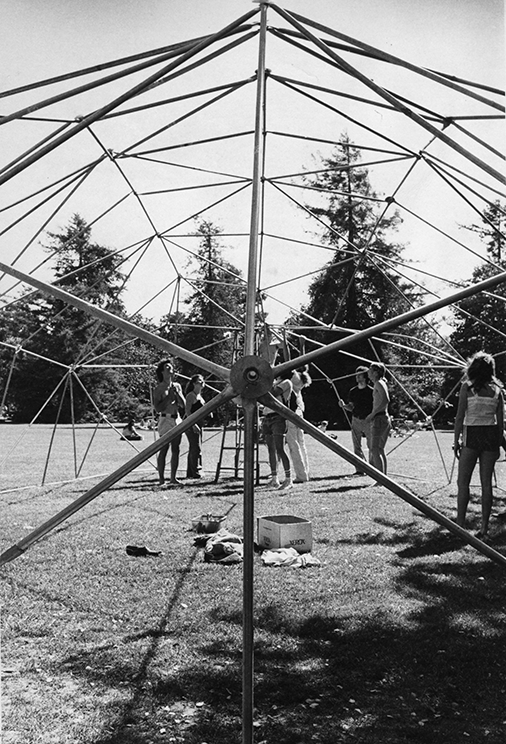
Early on, a roster of speakers and presenters were also important to the program. Roger Davis recalled yoga gurus and a Russian tantric Buddhist as part of the first event. He said the spiritual teacher Ram Dass, popular at the time for talking about consciousness and transformation, spoke about looking at the Earth as a holistic system.
In 1978, the famous futurist Buckminster Fuller headlined the event, providing the keynote inside Recreation Hall discussing “Space Exploration for Humanity.” At the time, he was vocal about Earth’s finite resources and humanity’s role in preserving them.
That same year, LSD evangelist and former Harvard psychologist Timothy Leary debated Stewart Brand, publisher of the counterculture magazine Whole Earth Catalog.
Cesar Chavez spoke at the festival in 1989. Then-presidential candidate Jerry Brown appeared in 1992. Actor Ed Begley Jr. came to talk about the value of electric vehicles in 1997. José Argüelles returned several times as a speaker.
“Back [in the] ’80s I dropped by the Quad to hear Desmond Tutu,” Mario J. Avila Sobarzo, Ph.D. ’89, shared. “To my surprise I sat just a couple of yards from ... Jane Fonda!”
From those early days, the festival’s regular master of ceremonies was peace activist and countercultural icon Wavy Gravy. Usually in his clown persona, Wavy Gravy brought levity to the event, comedically announcing the next act on the main stage and walking his (fake) pet fish around the Quad.
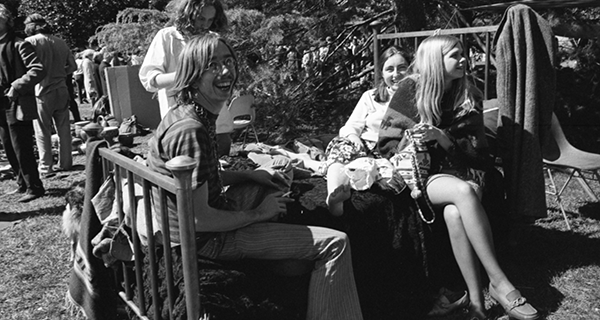
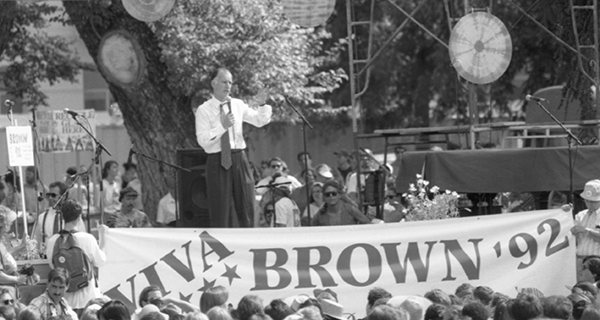
His approach also inspired the nonviolent methods of the Karma Patrol, the festival’s volunteer security keepers. (It is now called Chaos Control.) Tactics included, “Please don’t do that; please do this instead.” Friendly Karma Patrollers could often be heard on the Quad coaxing tree climbers to, “Please come down from the tree!”
“In 1980, the festival kicked off on Saturday morning with a greeting from Wavy Gravy, ‘It’s a new day! Thank God, it’s a new day,’” said Jim Hauer ’82. “I've been using that exclamation ever since.”
The festival saw its share of controversy over the decades. Early critics accused the event of commercialism over education.
Its hippie reputation offered an easy punchline. “I’m not a hippy [sic], and the festival’s image has always puzzled me,” Tom Davis ’79 told The California Aggie in 1979, when he was assistant director of the festival.
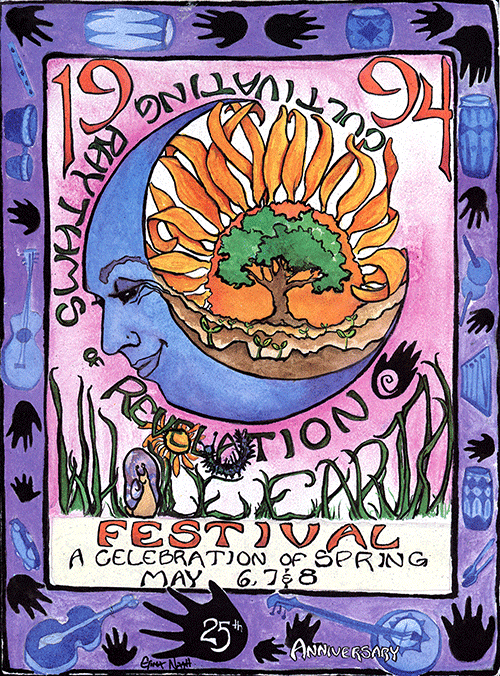
In the 1980s, the tradition of camping during Whole Earth weekend took a hit. Initially, festival campers were permitted to stay at the Aggie Villa site (currently the location of Aggie Village). In 1980, 150 campers pitched tents on a 40-acre field south of Richards Boulevard, but the next year, with the spot unavailable, they turned to the Yolo County Board of Supervisors for an alternative location, according to an article in the Woodland Daily Democrat. The Davis city council provided a site on Olive Drive that year. However, in 1982 the university administration advised the ASUCD Experimental College, festival sponsor at the time, that camping would not be a part of Whole Earth. The organization agreed that the event would proceed without camping.
According to Abundant Harvest: The History of the University of California, Davis, the festival continued annually as a self-supporting event until the late 1990s, when the administration considered canceling it due to waning student participation and complaints. “With some reorganization in 1999, however, nearly 30,000 people attended the three-day affair.”
At the opening ceremony in 2011, alumna Carolyn Shine ’71 honored Argüelles as the founder of the festival shortly after his death at age 72 from peritonitis.
“He was the ultimate art teacher — the art of your own life,” Shine told The Davis Enterprise in 2011.
Here and now
Today, passion for the Whole Earth Festival is in no short supply. Junior Tinka Peterka, who co-directs this year’s festival, has been involved since her freshman year. “There is a strong community of people involved year after year,” Peterka said.
But despite that core group’s constancy, the festival continues to evolve.
Amelia Evard ’18 co-directed the festival as a senior and is now a UC Davis law student. She said the most salient change has been the growing emphasis on cultural competency. “I think the effort to uplift voices from the many cultures present at the festival will be a continual process,” she said, citing the increasing diversity of the staff.

That diversity increases the breadth of perspectives evident in festival programming, she added.
Evard credited the experience for helping her understand how much student volunteers’ ideas influence the festival’s focus.
“When I became one of the directors, I saw how much of the direction of the festival is shaped by the students who work on it every year,” she said.
She also helped organize every facet of the festival. In addition to music and crafts, the workshops and exhibits on sustainability and environmental justice remain core components connecting the festival to its roots.
These, along with sustainability efforts — like food vendors’ use of reusable dishes and the prohibition of sales of bottled soft drink and water — show a zero-waste lifestyle in action. Education booths also offer information about relevant environmental and sustainability concerns.
Three different spaces provide unique festival experiences. The Art Space functions as an curated outdoor gallery, highlighting work aligned with the festival’s themes, while the Experiential Space is an interactive area offering attendees unique sensory experiences, such as a coffee-bean smelling table. The Kids Space gives children the opportunity to make crafts using sustainable materials, with parental guidance.
“Whole Earth Festival is a great avenue for sharing ideas and creating change,” said Peterka. “Our sustainable efforts and education booths are a way to bring awareness to environmental and social issues in an inviting way for those who have never been exposed to them.”
It’s also a backdrop for having fun with friends and creating memorable experiences.
“All of my favorite memories of Whole Earth — and my best friends from college — include people I’ve met and worked with,” said Evard.
Peterka described a letter from an elderly festival-goer who thanked staff members for their hard work.
“He met his now-wife at the festival almost 40 years ago, proposed to her there a year later, and continues to come with her and the rest of his family each year,” she said.
Festival preparation begins in December and comes to a head on the Wednesday the week of the festival.
To set up, the staff spends Wednesday constructing geodomes, stages and booths. Thursday is used to organize vendors and tie up loose ends.
Through the weekend, each of the about 250 volunteers — all trained by Chaos Control coordinators — is assigned a different task, such as providing customer service, sorting compost, or shuttling reusable dishes back and forth from dishwashers, among others. Though the festival is work-intensive, Evard said she loved seeing it all pay off.
“One of my favorite memories is leaving the main dome with my friends on Saturday night to watch the headliner from backstage after a long day coordinating the volunteers,” she said. “It rained all day, which required creative solutions to various issues we hadn’t foreseen. But watching the crowd dance around and have a good time made it clear we’d done a good job creating a fun and unique experience.”
For Peterka, seeing the festival conclude for another year is cause for reflection and a renewed commitment to its values.
“There’s something special and bittersweet about taking down the festival, sleep-deprived at 3 a.m., with new and old friends, [and then] watching the sunrise,” she said. “‘Whole Earth’ means acknowledging all the variables that contribute to the world as we know it. We’re all on this Earth together.”
Library Exhibit Spotlights Whole Earth Festival
The UC Davis Library showcases Whole Earth Festival memorabilia through the years in its new exhibition, A Sustainable Groove: 50 Years of the Whole Earth Festival, on display until July 1 at Peter J. Shields Library. Curated by Kevin C. Miller, interim head of Special Collections and university archivist, the exhibit features historical material from both the University Archives and the Whole Earth Festival Archive, highlighting the festival’s impact on the Davis community. The collection includes photography and artwork, as well as an original Karma Patrol T-shirt, worn by festival volunteers in the 1990s. — Josephine Thornton
